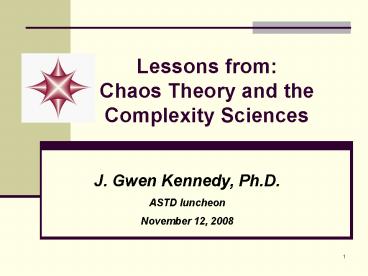Lessons from: Chaos Theory and the Complexity Sciences PowerPoint PPT Presentation
1 / 16
Title: Lessons from: Chaos Theory and the Complexity Sciences
1
Lessons from Chaos Theory and the Complexity
Sciences
J. Gwen Kennedy, Ph.D. ASTD luncheon November 12,
2008
2
Must go faster
- Life
- much faster pace
- www new technologies
- globalization
- increased diversity in our workforce and
customers - Clients demand faster, lower cost, better quality
3
The First World View
- Language of
- Either/or
- Beginnings and endings
- Right or wrong
- Control
- Predictability
Linear View
4
A Second World View
Systems View
- Language of
- Boundaries
- Pieces and Parts
- Comparisons
- Movement
5
A Third World View
Complex Adaptive Systems
- Language of
- Interconnectedness
- Non-linearity
- Dynamic
- Unpredictability
- Emergence
- Self-organizing
6
Patterns of Behaviors in Human Systems
Low
Random Chaotic
Self-Organizing Complex
Agreement
Rational Simple
High
Predictability of Outcome
High
Low
Adapted from Ralph Staceys Agreement and
Certainty Matrix found in Edgeware Insights from
Complexity Science for Health Care Leaders, pp.
136-143.
7
Eoyangs CDE Model
C Container D Differences E Exchanges
The container is the boundary that define what is
in and what is out, i.e. the shared goal,
collective consciousness, the common ground, the
box. Differences determine the primary patterns
of behavior that emerge within the system. While
there are many differences, focus on which
difference makes a difference - either positive
or negative. Exchanges of information, energy
and resources across differences. Focus on what
exchanges transform the system - change the
direction, speed, or effectiveness of the system.
8
Zimmermans STAR Model
9
Self-Organizing Exercise
- Craig Reynoldss BOIDS. The basic flocking model
uses three simple steering behaviors based on - Separation
- Alignment
- Cohesion
- Without verbally or non-verbally communicating,
identify two other participants. Stay equal
distant from your two people. Be safe, do not
collide with or run into anyone. And if possible
move in the same general direction as a group.
10
Simple Rules
- Simple rules guide complex systems.
- In human systems simple rules are the core values
in action.
11
Simple Rules cont.
- You can discover your rules in your story of
critical decisions the cross-roads the
decision that has shaped your path.
12
Your Own Simple Rules
- Think of a situation where you had to make a
critical decision. - What was the situation?
- What made it difficult?
- What did you consider?
- What did you decide?
- How has it made a difference?
- Share your story with one other.
- What did s/he hear?
13
Personal Simple Rules
- Always go for the learning experience
- There will always be enough money
- Respect and value others
- Seek serendipity and synchronicity
14
Positive Deviance
- Positive Deviance (PD) is an approach to
personal, organizational and cultural change
based on the idea that every community or group
of people performing a similar function has
certain individuals (the "Positive Deviants")
whose special attitudes, practices/ strategies/
behaviors enable them to function more
effectively than others with the exact same
resources and conditions. - Same resources different behaviors
- Reinforcing desired behaviors
- Learning through discovery within the community
- E.g. Jerry and Monique Sternins work with child
nutrition in Vietnam
15
Resources
- Olson, E. and Eoyang, G. (2001). Facilitating
organization change Lessons from complexity
science. San Francisco Jossey-Bass/Pfeiffer - Eoyang, Glenda (2003). Voices from the field An
introduction to human systems dynamics. Circle
Pines, MN Human Systems Dynamics Institute - Zimmerman, B., Lindberg, C. Plsek, P. (2001).
Edgeware Insights from complexity science for
health care leaders. Irving , TX VHA, Inc. - www.gkennedy.com
- http//www.hsdinstitute.org/
- www.plexusinstitute.org.
16
- J. Gwen Kennedy, Ph.D.
- Kennedy Associates
- Facilitating staff and organizational development
- (907) 337-4562 (phone)
- Website www.gkennedy.com
- E-mail gkennedy_at_alaska.com

